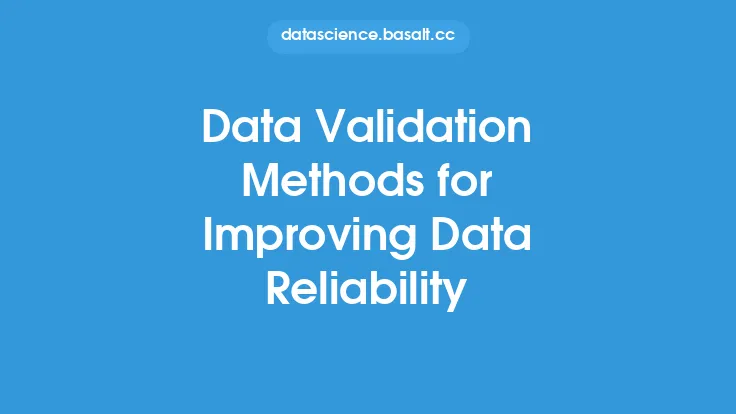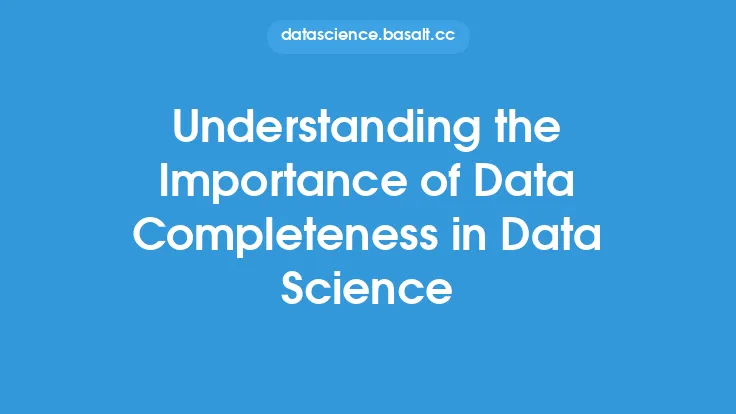Improving data completeness is a crucial aspect of data quality, as it directly affects the accuracy and reliability of insights derived from the data. Incomplete data can lead to biased models, incorrect conclusions, and poor decision-making. Therefore, it is essential to implement strategies that ensure data completeness, especially in datasets used for critical applications such as machine learning, business intelligence, and data analytics.
Understanding Data Completeness
Data completeness refers to the extent to which a dataset contains all the required information, without any missing or null values. A complete dataset is one that has all the necessary data points, and each data point has a valid value. Data completeness is often measured using metrics such as completeness ratio, which is the ratio of the number of complete records to the total number of records in the dataset. Achieving high data completeness is challenging, especially in large datasets, where data is collected from multiple sources, and data quality issues are common.
Data Profiling and Exploration
One of the first steps in improving data completeness is to perform data profiling and exploration. This involves analyzing the dataset to identify missing values, data distributions, and relationships between variables. Data profiling helps to understand the data quality issues, such as missing values, outliers, and inconsistencies, which can affect data completeness. Data exploration involves using statistical and visualization techniques to understand the data characteristics, such as mean, median, mode, and standard deviation. This step helps to identify areas where data completeness can be improved.
Data Validation and Verification
Data validation and verification are critical steps in ensuring data completeness. Data validation involves checking the data against a set of rules, such as data type, format, and range, to ensure that it conforms to the expected standards. Data verification involves checking the data against external sources, such as reference data, to ensure that it is accurate and consistent. Data validation and verification can be performed using various techniques, such as data quality checks, data cleansing, and data normalization.
Data Imputation and Interpolation
Data imputation and interpolation are techniques used to fill missing values in a dataset. Data imputation involves replacing missing values with estimated values, based on the patterns and relationships in the data. Data interpolation involves estimating missing values using statistical models, such as regression and machine learning algorithms. Data imputation and interpolation can be performed using various techniques, such as mean, median, and mode imputation, regression imputation, and multiple imputation.
Data Standardization and Normalization
Data standardization and normalization are essential steps in improving data completeness. Data standardization involves converting data into a standard format, such as date, time, and currency, to ensure consistency and comparability. Data normalization involves scaling data to a common range, such as 0 to 1, to prevent differences in scales from affecting data analysis. Data standardization and normalization can be performed using various techniques, such as data transformation, data aggregation, and data feature scaling.
Data Quality Monitoring and Reporting
Data quality monitoring and reporting are critical steps in ensuring data completeness. Data quality monitoring involves continuously checking the data for quality issues, such as missing values, outliers, and inconsistencies. Data reporting involves generating reports on data quality issues, such as data completeness, data accuracy, and data consistency. Data quality monitoring and reporting can be performed using various techniques, such as data quality dashboards, data quality metrics, and data quality alerts.
Data Governance and Stewardship
Data governance and stewardship are essential aspects of improving data completeness. Data governance involves establishing policies, procedures, and standards for data management, to ensure that data is accurate, complete, and consistent. Data stewardship involves assigning responsibilities to individuals or teams, to ensure that data is properly managed, maintained, and updated. Data governance and stewardship can be performed using various techniques, such as data governance frameworks, data stewardship programs, and data quality committees.
Conclusion
Improving data completeness is a critical aspect of data quality, as it directly affects the accuracy and reliability of insights derived from the data. By implementing strategies such as data profiling and exploration, data validation and verification, data imputation and interpolation, data standardization and normalization, data quality monitoring and reporting, and data governance and stewardship, organizations can ensure that their datasets are complete, accurate, and consistent. By prioritizing data completeness, organizations can make better decisions, improve business outcomes, and gain a competitive advantage in the market.





